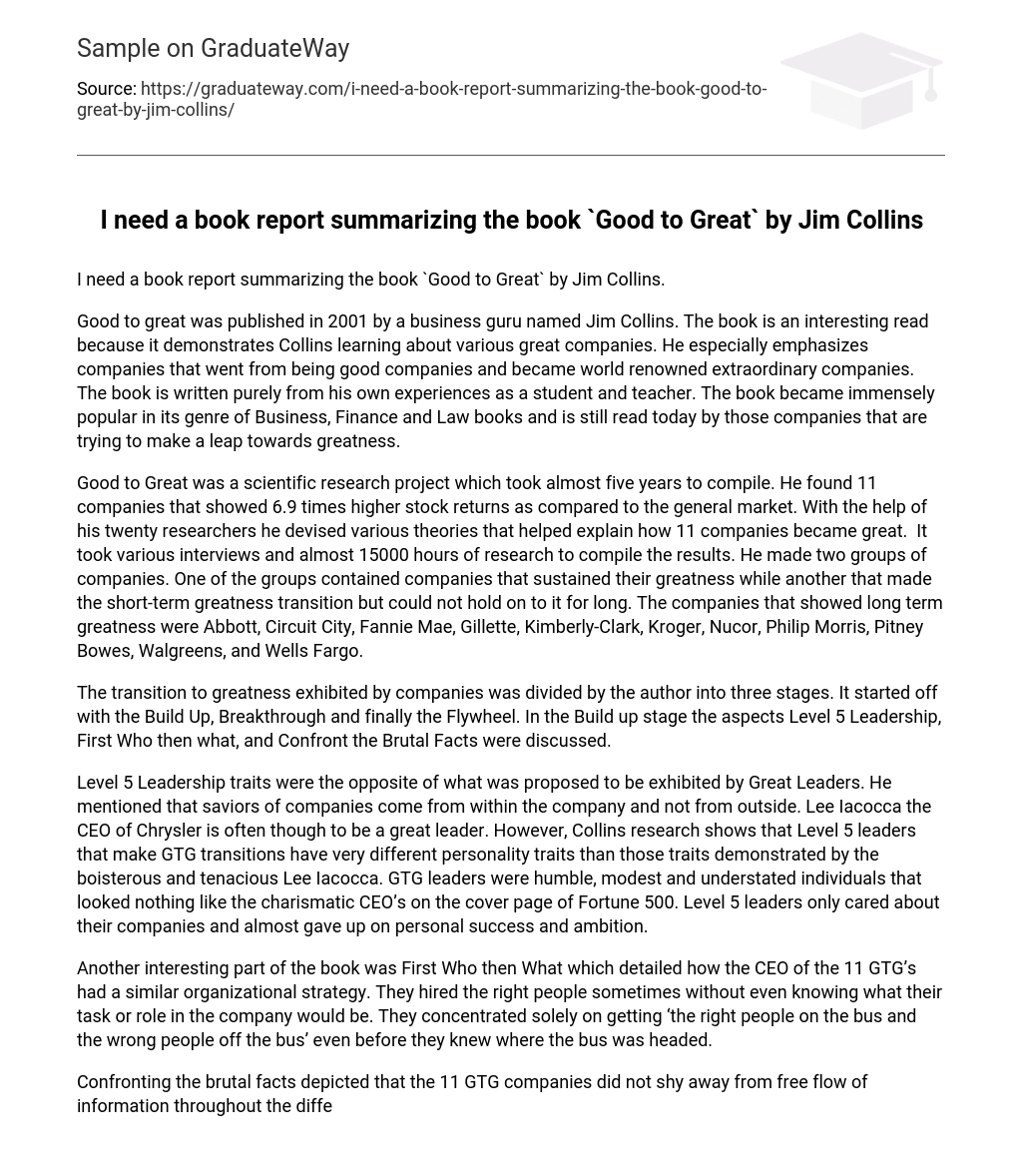I need a book report summarizing the book `Good to Great` by Jim Collins.
Good to great was published in 2001 by a business guru named Jim Collins. The book is an interesting read because it demonstrates Collins learning about various great companies. He especially emphasizes companies that went from being good companies and became world renowned extraordinary companies. The book is written purely from his own experiences as a student and teacher. The book became immensely popular in its genre of Business, Finance and Law books and is still read today by those companies that are trying to make a leap towards greatness.
Good to Great was a scientific research project which took almost five years to compile. He found 11 companies that showed 6.9 times higher stock returns as compared to the general market. With the help of his twenty researchers he devised various theories that helped explain how 11 companies became great. It took various interviews and almost 15000 hours of research to compile the results. He made two groups of companies. One of the groups contained companies that sustained their greatness while another that made the short-term greatness transition but could not hold on to it for long. The companies that showed long term greatness were Abbott, Circuit City, Fannie Mae, Gillette, Kimberly-Clark, Kroger, Nucor, Philip Morris, Pitney Bowes, Walgreens, and Wells Fargo.
The transition to greatness exhibited by companies was divided by the author into three stages. It started off with the Build Up, Breakthrough and finally the Flywheel. In the Build up stage the aspects Level 5 Leadership, First Who then what, and Confront the Brutal Facts were discussed.
Level 5 Leadership traits were the opposite of what was proposed to be exhibited by Great Leaders. He mentioned that saviors of companies come from within the company and not from outside. Lee Iacocca the CEO of Chrysler is often though to be a great leader. However, Collins research shows that Level 5 leaders that make GTG transitions have very different personality traits than those traits demonstrated by the boisterous and tenacious Lee Iacocca. GTG leaders were humble, modest and understated individuals that looked nothing like the charismatic CEO’s on the cover page of Fortune 500. Level 5 leaders only cared about their companies and almost gave up on personal success and ambition.
Another interesting part of the book was First Who then What which detailed how the CEO of the 11 GTG’s had a similar organizational strategy. They hired the right people sometimes without even knowing what their task or role in the company would be. They concentrated solely on getting ‘the right people on the bus and the wrong people off the bus’ even before they knew where the bus was headed.
Confronting the brutal facts depicted that the 11 GTG companies did not shy away from free flow of information throughout the different levels of management. This meant that each and every employee had equal information, equal chance to give suggestions and take part in decision making.
The Breakthrough stage of transition was divided into 3 aspects: a hedgehog concept, culture of discipline, and technology accelerators. The Hedgehog concept explained how GTG companies were determined to find core concepts that made them great as opposed to management fads that appeared to work for awhile only. It was essential for these GTG companies to realize what things they shouldn’t do completely and what they should stop doing immediately. Culture of Discipline explained how bureaucracy and micromanagement helped little in achieving targets. Disciplined people action and thoughts were needed to deliver the best results. The most important point made in the Technology accelerator part was that adoption of technology is an important tool for success but it should never solely drive a company to victory.
Sustaining Performance was the last stage of the Good to great transition and required almost similar or slightly less effort than the Breakthrough stage. Since GTG companies had not relied on one particular strategy or person it was relatively easy to maintain or sustain this growth. The flywheel was an analogy used to explain this phenomenon.
In my opinion it was a revolutionary book that changed what was previously thought of as the ingredients to success. Collins made sure that companies and individuals realize that greatness is achieved not by a one time effort but a lifetime of holistic discipline and great determination.
WORKS CITED:
Collins, Jim. Good to Great. HarperCollins Publishers: 2001





